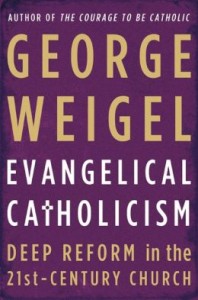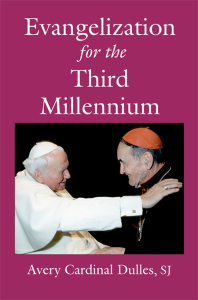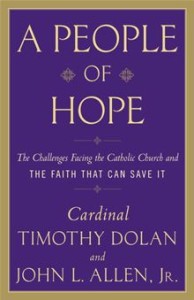these resources offer a deep dive into the New Evangelization.
Books
 Evangelical Catholicism: Deep Reform in the 21st-Century Church (Basic Books, 2013) by George Weigel – This missionary manifesto offers a blueprint for applying the New Evangelization to every aspect of the Church, from lay people, to priests, bishops, the liturgy, and more.
Evangelical Catholicism: Deep Reform in the 21st-Century Church (Basic Books, 2013) by George Weigel – This missionary manifesto offers a blueprint for applying the New Evangelization to every aspect of the Church, from lay people, to priests, bishops, the liturgy, and more.
Forming Intentional Disciples (Our Sunday Visitor, 2012) by Sherry Weddell – A groundbreaking, practical guide to carrying out the New Evangelization in parishes and producing sincere disciples of Jesus Christ.
Bad Religion: How We Became a Nation of Heretics (Free Press, 2012) by Ross Douthat – A thorough look at the history and landscape of American Christianity with an emphasis on its various distortions. Douthat argues that America is not becoming less religious but less orthodox.
The Resurrection of the Son of God (Fortress Press, 2003) by N.T. Wright – The definitive scholarly work on Jesus’ bodily Resurrection from the dead by a renowned Anglican biblical scholar.
 Evangelization for the Third Millennium (Paulist Press, 2009) by Avery Cardinal Dulles – A compilation of talks and articles on how Vatican II, Pope Paul VI, and Pope John Paul II paved the way for the New Evangelization. Cardinal Dulles also examines the relationship evangelization has with apologetics, catechesis, and ecumenism.
Evangelization for the Third Millennium (Paulist Press, 2009) by Avery Cardinal Dulles – A compilation of talks and articles on how Vatican II, Pope Paul VI, and Pope John Paul II paved the way for the New Evangelization. Cardinal Dulles also examines the relationship evangelization has with apologetics, catechesis, and ecumenism.
John Paul II and the New Evangelization: How You Can Bring the Good News to Others (Servant, 2006) edited by Ralph Martin – Essays covering the theological roots, ecumenical dimensions, and practical strategies of the New Evangelization.
The New Evangelization: Overcoming the Obstacles (Paulist Press, 2008) edited by Steven Boguslawski and Ralph Martin – A series of talks on the greatest challenges presented by the New Evangelization today, written by distinguished thinkers like Avery Cardinal Dulles, Francis Cardinal George, Fr. John Richard Neuhaus, Fr. Francis Martin, and Dr. Edwin Hernandez.
The New Evangelization: Responding to the Challenge of Indifference (Gracewing Publishing, 2012) by Rino Fisichella – The president of the Pontifical Council for Promoting the New Evangelization explores its effects on culture, politics, beauty, and art.
 Bridging the Great Divide: Musings of a Post-Liberal, Post-Conservative Evangelical Catholic (Rowman & Littlefield, 2004) by Robert Barron – Fr. Barron examines the roots of “beige Catholicism”, one of the great barriers to the New Evangelization, and offers several insightful solutions.
Bridging the Great Divide: Musings of a Post-Liberal, Post-Conservative Evangelical Catholic (Rowman & Littlefield, 2004) by Robert Barron – Fr. Barron examines the roots of “beige Catholicism”, one of the great barriers to the New Evangelization, and offers several insightful solutions.
Set All Afire (Ignatius Press, 1991) by Louis de Wohl – A fictional account of the Church’s most prodigious missionary saint, St. Francis Xavier. You’ll journey with St. Francis from Europe to Goa, India, Malaysia, and Japan as he sets the Orient ablaze with the fire of Christ.
Absolute Relativism: The New Dictatorship and What to Do about It (Catholic Answers, 2011) by Chris Stefanick – A short, clear introduction to relativism along with suggestions on overcoming it.
Catholics Come Home: God’s Extraordinary Plan for Your Life (Image, 2013) by Tom Peterson – The founder of Catholics Come Home shares how he’s helped thousands of inactive Catholics return to the Church.
New Ecclesial Movements: Communion and Liberation, Neo-catechumenal Way, Charismatic Renewal (Alba House, 2006) by Tony Hanna – An introduction and analysis of the many evangelistic communities which have sprung up in the wake of the Second Vatican Council.
 A People of Hope: The Challenges Facing the Catholic Church and the Faith That Can Save It (Image, 2013) by Cardinal Timothy Dolan and John L. Allen, Jr. – A book-length interview between an insightful Vatican reporter and one of today’s greatest evangelists. Dolan’s “affirmative orthodoxy” is on full display as he touches on many challenges to faith.
A People of Hope: The Challenges Facing the Catholic Church and the Faith That Can Save It (Image, 2013) by Cardinal Timothy Dolan and John L. Allen, Jr. – A book-length interview between an insightful Vatican reporter and one of today’s greatest evangelists. Dolan’s “affirmative orthodoxy” is on full display as he touches on many challenges to faith.
The Church and New Media: Blogging Converts, Online Activists, and Bishops Who Tweet (Our Sunday Visitor, 2011) by Brandon Vogt – Pardon the shameless plug, but this Catholic guide to the digital continent uses stories and examples to show how the new media can fuel the New Evangelization.
The Unintended Reformation: How a Religious Revolution Secularized Society (Belknap Press, 2012) by Brad Gregory – A high-level examination of the religious, social, and economic forces that have led to our secularized world.
How to Defend the Faith Without Raising Your Voice: Civil Responses to Catholic Hot-Button Issues (Our Sunday Visitor, 2012) – This apologetics handbook includes many practical tips and strategies for defending the faith effectively.
Treasure in Clay: The Autobiography of Fulton J. Sheen (Image Books, 1982) – Stories from the life and ministry of one of last century’s greatest evangelists.
The Way of the Disciple (Ignatius Press, 2003) by Erasmo Merikakis – An illuminating guide toward developing the proper evangelical disposition.
Church Documents
Inter Mirifica (1963), Second Vatican Council – The Church’s definitive document on modern communication tools. It encourages the “new methods” Pope John Paul II later called for.
Gaudium et Spes (1965) – The Second Vatican Council’s constitution on the Church in the modern world, which includes a savvy analysis on why people resist God today.
Ad Gentes (1965), Vatican II – The Council’s decree on the Church’s missionary activity.
Evangelii Nuntiandi (1975), Pope Paul VI – Perhaps the most important modern Church document on evangelization, it urges all Catholics—priests, religious, catechists, parents, and lay faithful—to evangelize in their daily lives.
Gaudete in Domnio (1975), Pope Paul VI – An exhortation to Christian joy in which the Pope turns to the Holy Spirit, the Bible, and the saints as sources of true joy.
Redemptoris Missio (1990), Pope John Paul II – Pope John Paul’s encyclical on the Church’s missionary activity which emphasizes the urgency of evangelization.
Letter to Artists (1999), Pope John Paul II – The pope’s magnificent reflection on art, faith, and our innate desire for beauty.
Novo Millennio Ineunte (2000), Pope John Paul II – The Pope’s apostolic letter written at the beginning of the third millennium encouraging Catholics to be “filled with the ardor of the apostolic preaching which followed Pentecost” (40).
The Rapid Development (2005), Pope John Paul II – Pope John Paul’s last official document, which focused on social communications and the internet, in particular.
Ubicumque et Semper (2010), Pope Benedict XVI – The apostolic letter which established the Pontifical Council for Promoting the New Evangelization and outlined its mission.
Message to the People of God (2012), Synod on the New Evangelization for the Transmission of Christian Faith – The Synod’s concluding document, addressed to the entire Church, highlighting many expressions of the New Evangelization.
Evangelii Gaudium (2013), Pope Francis – A joyful call to evangelization which touches every aspect of Church life, creating a “culture of encounter” through which people come to know the Lord Jesus.
